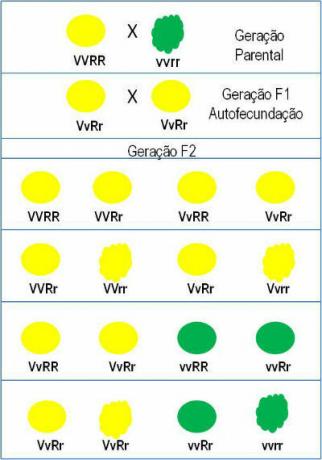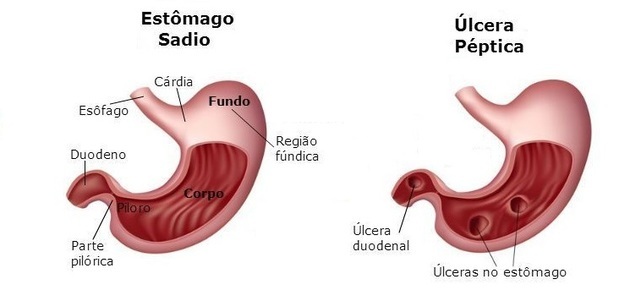Mendel's Second Law or Independent Segregation Law it is based on the combined transmission of two or more characteristics.
Mendel began studies with peas following the expression of genes in isolation. This fact gave rise to Mendel's First Law.
Later, Mendel began to study the segregation of two genes simultaneously. For example, he crossed green, rough seeds with yellow, smooth seeds.
Mendel's goal was to find out if these characteristics were related, ie does a yellow seed necessarily have to be smooth?
To answer this question, Mendel performed crosses to analyze the transmission of characteristics related to seed color and texture.
Mendel's 2nd Law concludes that genes from two or more characters are transmitted to gametes independently.
Peas experiment
Mendel crossed yellow and smooth seeds with green and wrinkled seeds (Parental Generation). The simultaneous monitoring of two pairs of allele genes is called diibridism.
Yellow and smooth seeds have the VVRR genotype and are only able to form VR gametes.
Green and wrinkled seeds have the vvrr genotype and only have the possibility of forming vr gametes.
- The V allele conditions yellow peas;
- The v allele conditions green peas;
- The R allele conditions smooth peas;
- The r allele conditions wrinkled peas.
The crossing between the two seeds resulted in 100% of yellow and smooth seeds (Generation F1). Then, Mendel performed self-fertilization among the F1 Generation seeds.

Cross genotypes between smooth yellow and wrinkled green peas
The F2 generation is constituted by the following phenotypic proportion: 9 yellow and smooth, 3 yellow and wrinkled; 3 green and smooth; 1 green and rough.
Mendel concluded that color inheritance was independent of texture inheritance.
As a result, Mendel's 2nd Law can be stated as follows:
"The factors for two or more traits are segregated in the hybrid, distributing independently to the gametes, where they combine randomly."
Also read about:
- Introduction to Genetics
- gene interaction
- Gene Recombination
- Gregor Mendel
- Mendel's Laws
- Mendel's First Law
Exercise solved
1. (UFU-MG) In experiments involving three independent characteristics (tri-hybridism), if a cross between AaBbCc individuals is performed, the frequency of AABbcc offspring will be equal to:
a) 8/64
b) 1/16
c) 3/64
d) 1/4
e) 1/32
Resolution
To resolve the issue, the crossing of alleles must be performed:
Aa x Aa → AA AaAa aa = frequency of 1/4;
Bb x Bb → BB bb bb bb = frequency of 1/2;
Cc x Cc → CC Cc Cc cc = frequency of 1/4.
When adding the frequencies, we have: 1/4 x 1/2 x 1/4 = 1/32.
Reply: letter e) 1/32
Entrance Exam Exercises
1. (FUVEST-2007) In Labrador dogs, two genes, each with two alleles (B/b and E/e), condition the three typical coats of the breed: black, brown and golden. The golden coat is conditioned by the presence of the recessive and homozygous allele in the genotype. Dogs carrying at least one dominant E allele will be black if they have at least one dominant B allele; or brown if they are homozygous bb. Mating a golden male to a brown female produced black, brown and golden offspring. The male's genotype is
a) Ee BB.
b) E and Bb.
c) e and bb.
d) e and BB.
e) e and Bb.
e) e and Bb.
2. (Unifor-2000) In a given animal, the dark coat is conditioned by a dominant allele and the light coat by the recessive one. Long tail is determined by a dominant allele and the short by the recessive allele. By crossing double-heterozygous individuals with individuals with recessive characteristics, we obtained:
25% dark coat and long tail
25% dark coat and short tail
25% light coat and long tail
25% light coat and short tail
These results suggest that this is a case of:
a) quantitative inheritance.
b) gene interaction.
c) independent segregation.
d) genes in complete linkage.
e) genes in incomplete linkage.
c) independent segregation.
3. (Fuvest) The cross between two pea strains, one with yellow and smooth seeds (VvRr) and the other with yellow and wrinkled seeds (Vvrr), originated 800 individuals. How many individuals should be expected for each of the phenotypes obtained?
a) plain yellow = 80; wrinkled yellow = 320; plain green = 320; green-wrinkled = 80.
b) plain yellow = 100; yellow-wrinkled = 100; plain greens = 300; green-wrinkled = 300.
c) plain yellow = 200; yellow-wrinkled = 200; plain greens = 200; green-wrinkled = 200.
d) plain yellow = 300; wrinkled yellow = 300; plain greens = 100; green-wrinkled = 100.
e) plain yellow = 450; wrinkled yellow = 150; plain greens = 150; green-wrinkled = 50.
d) plain yellow = 300; wrinkled yellow = 300; plain greens = 100; green-rough=100.


